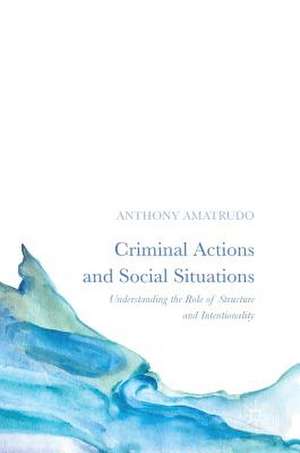Criminal Actions and Social Situations: Understanding the Role of Structure and Intentionality
Autor Anthony Amatrudoen Limba Engleză Hardback – 6 feb 2018
Preț: 453.84 lei
Nou
Puncte Express: 681
Preț estimativ în valută:
86.85€ • 94.31$ • 72.96£
86.85€ • 94.31$ • 72.96£
Carte tipărită la comandă
Livrare economică 23 aprilie-07 mai
Preluare comenzi: 021 569.72.76
Specificații
ISBN-13: 9781137457301
ISBN-10: 1137457309
Pagini: 244
Ilustrații: X, 196 p.
Dimensiuni: 148 x 210 mm
Greutate: 0.4 kg
Ediția:1st ed. 2018
Editura: Palgrave Macmillan UK
Colecția Palgrave Macmillan
Locul publicării:London, United Kingdom
ISBN-10: 1137457309
Pagini: 244
Ilustrații: X, 196 p.
Dimensiuni: 148 x 210 mm
Greutate: 0.4 kg
Ediția:1st ed. 2018
Editura: Palgrave Macmillan UK
Colecția Palgrave Macmillan
Locul publicării:London, United Kingdom
Cuprins
Section 1. Technical and Analytical Considerations.
Chapter 2. The Central Problem of Collective Action.
Chapter 3. Collective Actions and Goals.- Section 2. Legal Considerations.
Chapter 3. Mobs, Masses and Treating People as Groups.
Chapter 4. Criminal Groups and Their Enterprise in UK Criminal Law and in International Law.- Section 3. Reality and Sociology.
Chapter 5. Real-life Cases: War Criminal Prosecutions and the Treatment of Membership of Illegal Organisations.
Chapter 6. The Gang in Criminological Literature.
Chapter 7. Drawing the Strands Together
Notă biografică
Dr Anthony Amatrudo is Associate Professor of Criminology at Middlesex University School of Law, UK.
Textul de pe ultima copertă
This book develops a more nuanced, and technically rigorous, account of persons and groups in the context of intentional action and responsibility. Until now criminologists have taken groups as fairly straightforward associations and neglected the technical – and problematic – issues of how intention and action both structure membership and action. Amatrudo also assesses the often-overlooked fleeting nature of many groups and the overstated continuity of group membership, and this book has radical implications for the way we describe criminal groupings e.g. “criminal” groups with their loose bonds but tight sense of intentionality from criminogenic groups with their tight bonds and loose sense of intentionality. A key issue investigated here is the implications involved for people incarcerated on joint criminal enterprise charges and gang membership-related charges; and this timely topic will be of great interest to academics and students of Criminology, Law, Sociology and a variety of other Social Sciences. The volume will also be useful for lawyers, social workers, community workers and others involved in the criminal justice system.
Caracteristici
Interrogates the nature of responsibility and how people act within groups
Questions differing levels of culpability when people are engaged in a criminal act
Appeals to a wide range of scholars within the Social Sciences: criminologists, sociologists and practitioners
Questions differing levels of culpability when people are engaged in a criminal act
Appeals to a wide range of scholars within the Social Sciences: criminologists, sociologists and practitioners
